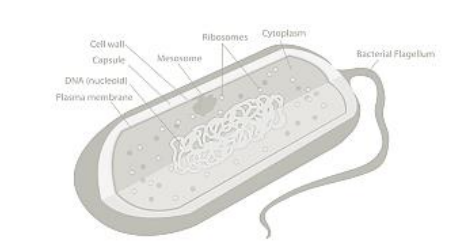In biology, cells are one of the most basic units of both structural and functional organization. Scientists jointly came up with this theory, known as the cell theory. Schleiden was a Belgian Botanist, and Schwan was a German Zoologist. Based on their studies of plant and animal cells, they came to the realization that animals and plants are composed of cells that perform different functions. The cell theory is what they came up with.
Based on the cell theory, we can say that:

The prokaryotes typically have a rod-like, or corkscrew-like shape, and are small, some measuring only a few micrometers. However, some giant species exceed the size of a human hair. Their plasma membrane encloses a single compartment, where the cytoplasm and DNA are contained, surrounded by a tough protective covering, called a cell wall.

A prokaryotic nucleus resides in a membrane, whereas a eukaryotic nucleus is membrane-bound.
DNA is usually found within the nucleoid of a prokaryotic cell.
Bacteria and archaea are prokaryotic cells. A bacteria's DNA does not reside in a nucleus, and its diameter is generally 0.1–5 μ m. DNA in their cells floats in the cytoplasm in a circular structure called a nucleoid. An organism with a single prokaryotic cell is known as a prokaryote.
Animals, plants, fungi, and protozoa contain eukaryotic cells. Their DNA is contained in membrane-bound nuclei that range from 10 to 100 micrometers in diameter. The eukaryotic cells that make up organisms are called eukaryotes.
DNA is found within the nucleus of eukaryotic cells.
Plant and animal cells perform many similar functions, but they are not all alike because nuclei and organelles within eukaryotic cells are membrane-bound. Plants, on the other hand, can create their own glucose through photosynthesis while animal cells rely on glucose from their food sources for cellular respiration. In order to produce food, the chloroplasts in the plant cell must use light. A cytoskeleton and plasma membrane support animal and plant cells, respectively. Animal cells do not have supporting cell walls, but plant cells do. The central vacuole within plant cells is a similar structure. Many of the functions of the cells in plants and animals are fulfilled by vesicles. Vesicles provide waste storage, transport, and many other functions.
Based on the cell theory, we can say that:
- The smallest unit of life, the cell, constitutes living organisms.
- By cell division, a new cell emerges from an existing one.
- Each cell functions independently from those around it, but is integral to the whole organism.
- It contains our inherited genetic material that we pass down from generation to generation.
- The prokaryotic cell
- The eukaryotic cell
Prokaryotes
Cells of prokaryotes are not nucleated nor do they contain any organelles encased in membranes. A prokaryote lacks a nucleus and so its genetic material DNA is not contained within it. A second difference between prokaryotes and eukaryotes is that the DNA in the former is less structured than the latter. There is only one loop of DNA in them. Eukaryotes have chromosomes that contain DNA. A few prokaryotes have multiple cells (multicellular), but most have just a single cell (unicellular). Bacteria and Archaea are two separate groups of prokaryotes.The prokaryotes typically have a rod-like, or corkscrew-like shape, and are small, some measuring only a few micrometers. However, some giant species exceed the size of a human hair. Their plasma membrane encloses a single compartment, where the cytoplasm and DNA are contained, surrounded by a tough protective covering, called a cell wall.
Eukaryotes
A eukaryote is a species of cell comprising a membrane-bound nucleus and membrane-bound organelles. Eukaryotes contain their genetic material in nuclei and their DNA is arranged into chromosomes. The eukaryotic organism may have multicellular components or may have a single cell. In eukaryotic cells, sterols are found in their membranes, while in prokaryotes only Mycoplasma's wall contains sterols. Every animal is eukaryotic. There are also fungi, plants, and protists in the eukaryote kingdom. Generally, eukaryotic cells tend to be larger and more complex than their bacterial and archaeal counterparts. In some cases, such as in amoebae and yeast, organisms live independently; in other cases, multicellular organisms live in assembles. Multicellular organisms made up of eukaryotic cells include plants, animals, and fungi.A prokaryotic nucleus resides in a membrane, whereas a eukaryotic nucleus is membrane-bound.
DNA is usually found within the nucleoid of a prokaryotic cell.
Bacteria and archaea are prokaryotic cells. A bacteria's DNA does not reside in a nucleus, and its diameter is generally 0.1–5 μ m. DNA in their cells floats in the cytoplasm in a circular structure called a nucleoid. An organism with a single prokaryotic cell is known as a prokaryote.
Animals, plants, fungi, and protozoa contain eukaryotic cells. Their DNA is contained in membrane-bound nuclei that range from 10 to 100 micrometers in diameter. The eukaryotic cells that make up organisms are called eukaryotes.
DNA is found within the nucleus of eukaryotic cells.
Plant and animal cells perform many similar functions, but they are not all alike because nuclei and organelles within eukaryotic cells are membrane-bound. Plants, on the other hand, can create their own glucose through photosynthesis while animal cells rely on glucose from their food sources for cellular respiration. In order to produce food, the chloroplasts in the plant cell must use light. A cytoskeleton and plasma membrane support animal and plant cells, respectively. Animal cells do not have supporting cell walls, but plant cells do. The central vacuole within plant cells is a similar structure. Many of the functions of the cells in plants and animals are fulfilled by vesicles. Vesicles provide waste storage, transport, and many other functions.
Get subject wise printable pdf notesView Here



No comments:
Post a Comment
Please don't spam. Comments having links would not be published.